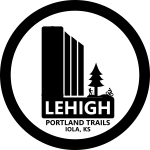Last weekend, we had THREE work crews in action, and accomplished a great deal:
Bridge Work
Volunteers have been working on bridge-related projects for the last month or so, and and there’s been a huge amount of progress. There are actually two bridge projects that have been happening simultaneously:
Hegwald Bridge
The “Hegwald Bridge” is a nearly century-old structure that was originally located on a county road in rural Allen County. When the bridge was slated for replacement, the County donated the bridge to the Lehigh Portland Trails project, and it was moved on-site, and has been sitting ever since. A few weeks ago, new concrete bridge abutments were installed by a local contractor with assistance from volunteers:

Our volunteers have also been busy repairing the old bridge, including replacing some of the railings that had been damaged by vehicles over the years:

The next step is sandblasting and painting the bridge, then placing it on the new abutments. It’s going to be beautiful!
Rail Bridge
This bridge crosses a small waterway towards the west end of the Lehigh Portland Trails. It was constructed out of old railroad rails donated by a local company, with decking and railings purchased locally, designed and constructed by volunteers. It’s not quite finished — it still needs more railings, and rock needs to be added to the approaches — but it was placed this weekend, and makes what was a very difficult crossing easy and attractive:

BMX Skills Area
There is a small quarry located in this eastern part of the property (this is NOT the quarry lake) that was used as the source for the rock for local farmhouses, and for the stone fences that bordered some of the old farmsteads. This quarry is about 150 feet to the side, roughly square, with 6-foot walls on three sides.
We’l planning to use this quarry as the site for a small “BMX Skills Area”, a place where riders can work on their bike handling skills and try out some simple stunts and tricks. We’ve had the quarry cleaned out for several months (it was filled with brush when we found it), but have been awaiting some clear dirt fill to begin building the features. The dirt arrived last week (courtesy of dirt and equipment from local businesses), and we got a chance to begin work. Here’s what we have so far:

This is the ramp leading from a quarry wall down into the pit. The idea is to let some riders get a bit of speed.

It’s a little difficult to see in this shot, but we have a bermed turn, a tabletop, two rollers, then another bermed u-turn.
The plan is to polish this small set of features, see if they work as intended, and then leave a pile of dirt for future expansion. We’ve only used up about one third of the area, so there’s room to grow!
Rest Shelter
A local scout is doing a service project in attempt to earn an Eagle merit badge. He chose to build a shelter for the trails. We provided him a location along the quarry lake bluffs, and he and his crew got the forms set and ready for concrete this weekend:

Singletrack Benchcutting
Another project that has been on the “to-do” list for awhile is a section of “benching” on what we call the “Mountain Goats Trail”. This trail, along the northern shore of the lake, traverses some rough terrain, including a very steep side-slope.
The trail has been minimally cleared for awhile, but without the benching, it was barely walkable, much less rideable.
“Benching” is the process of cutting a flat trail into a steep side-slope. Material (dirt and rock) is excavated from the hillside, leaving a path wide enough and flat enough to be useable by most riders and runners, and yet built to be sustainable so that it won’t erode over time. The process of benching a trail takes a great deal of time and effort, particularly when done by hand, as we needed to do.
Here’s what it looked like “before”:

As always, photos tend to flatten out terrain — it was actually much steeper than it looks here!
And the “after”:

This photo is from a slightly different perspective, but the cedar tree right-center in the first photo is left-center in this shot, and the trail has been benched into the hillside below the tree, using cedar logs, rocks, and lots of dirt dug out from the hillside, for about 50 feet. Time will tell if this will be a long-term solution, but at least it’s rideable now!
